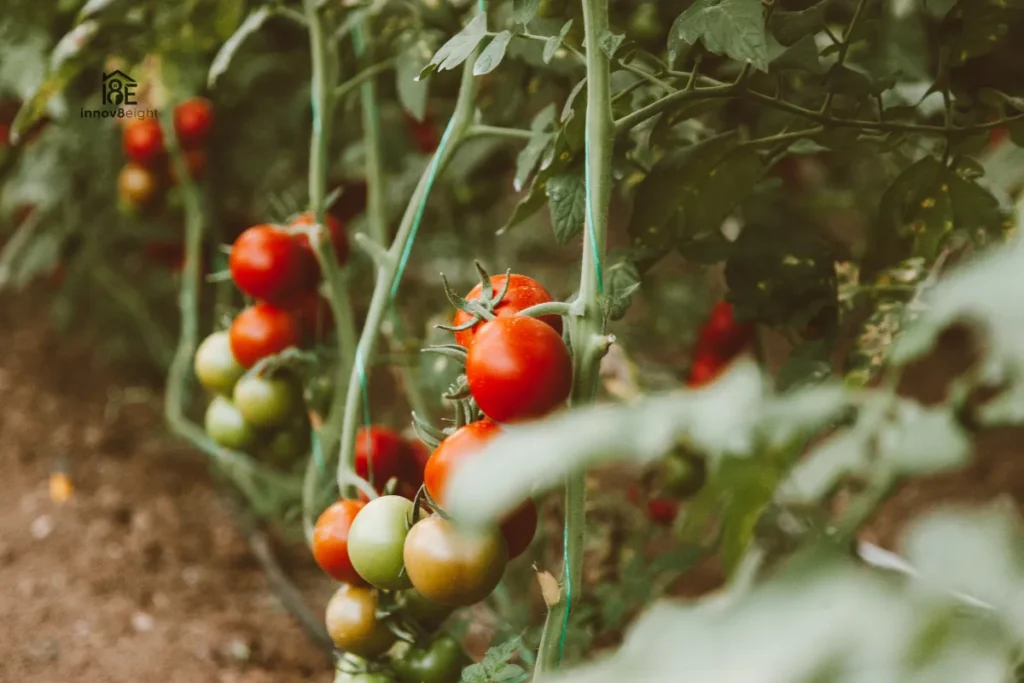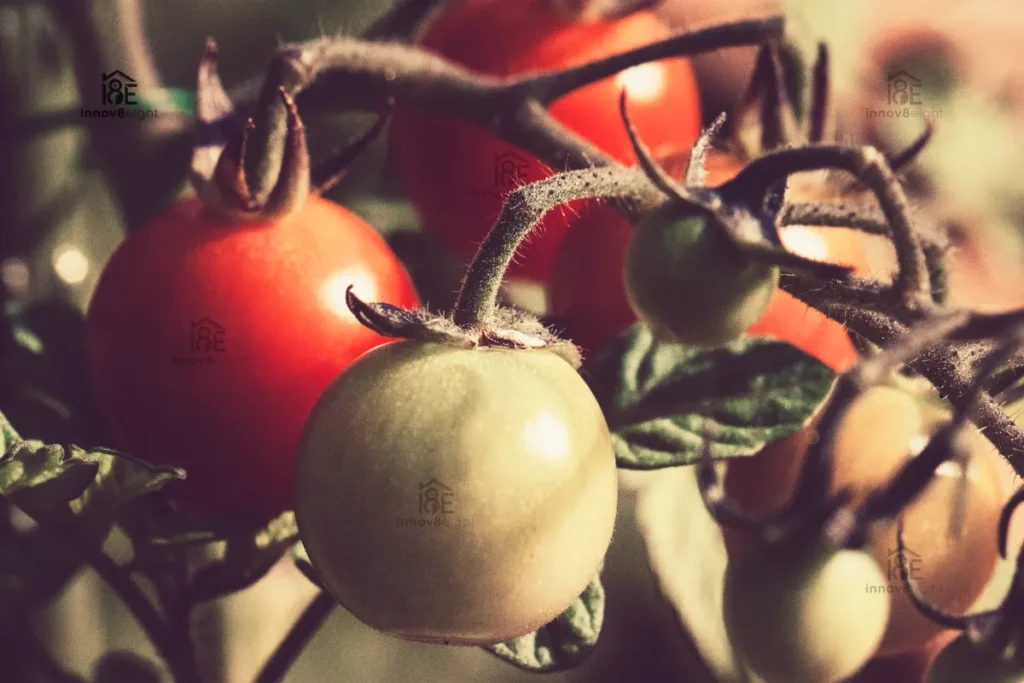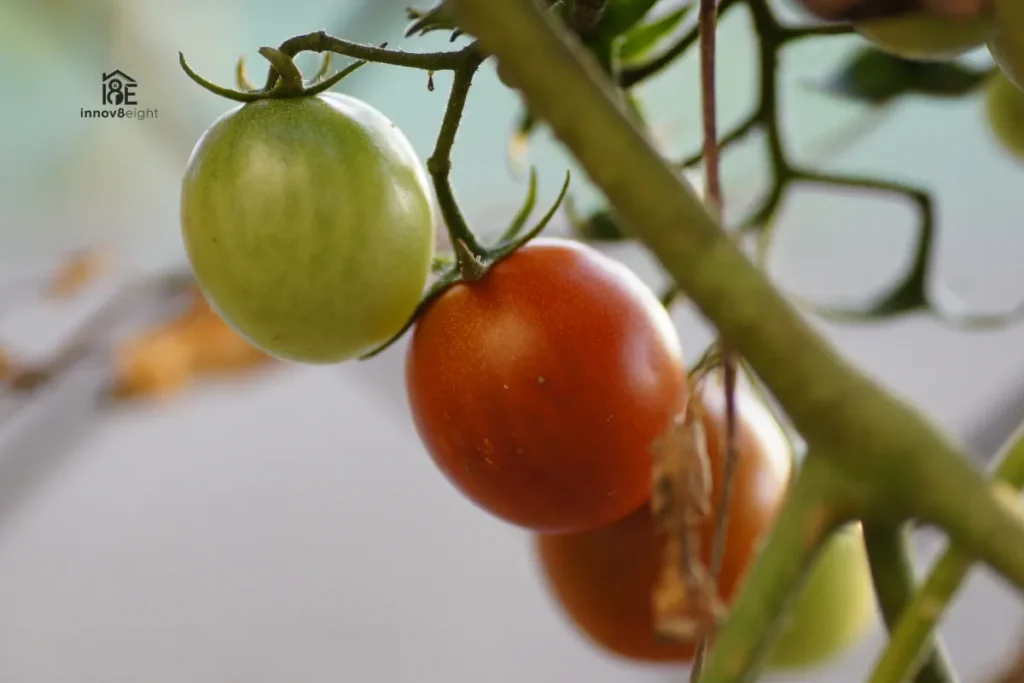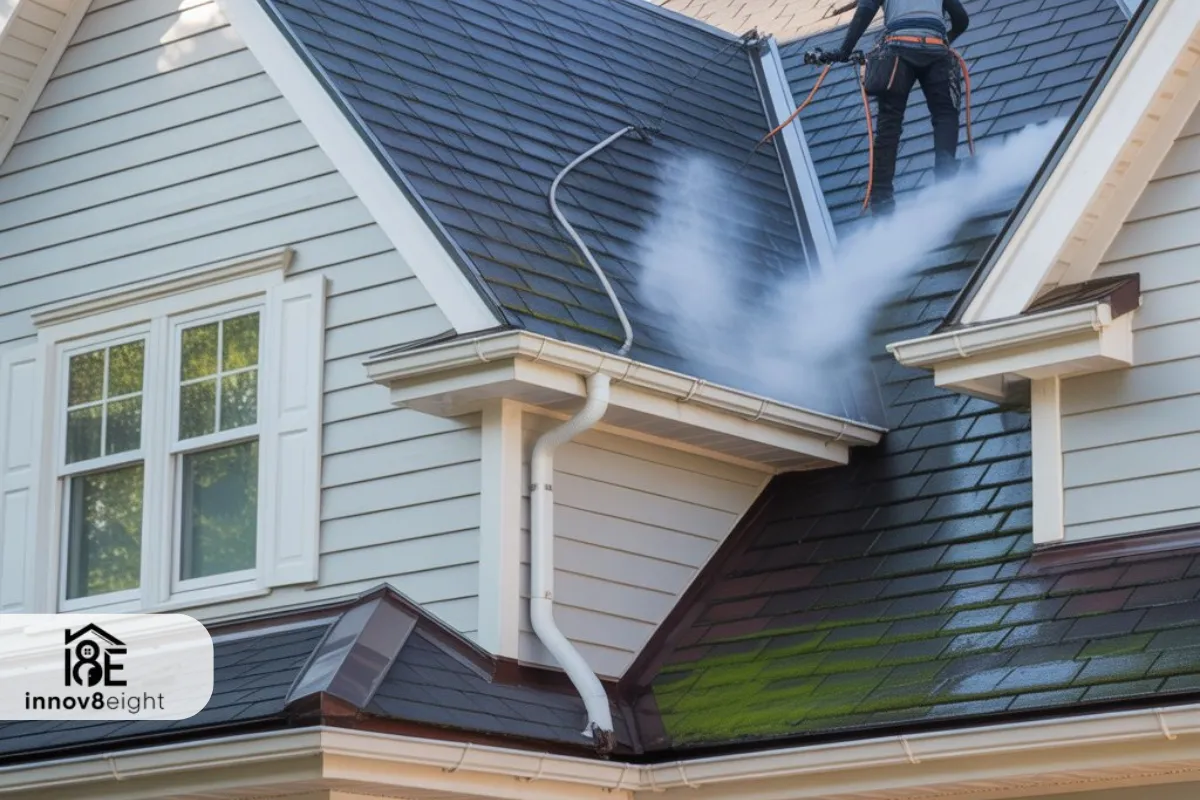Understanding Roma Tomatoes
If you’ve ever walked through a garden center or scrolled through a seed catalog, you’ve probably spotted Roma tomatoes. These are the small, oblong, red tomatoes that almost every home cook & gardener loves. But before you rush to plant them, you might be asking: “is Roma tomato determinate or indeterminate?” Don’t worry—we’re going to break it down in a way that’s easy to understand.
What Are Roma Tomatoes & Why They’re Popular
First, let’s talk about what Roma tomatoes are. They’re known as paste tomatoes, which means they have thick flesh & fewer seeds than other varieties. This makes them perfect for sauces, soups & canning. Home gardeners in the U.S. especially love Roma tomatoes because they’re reliable, produce a lot of fruit, & don’t require constant attention.
Determinate & Indeterminate Tomatoes Explained
Now, back to that big question: determinate vs. indeterminate. Imagine two kinds of tomato plants: one is like a compact little bush, & the other is a climbing vine that just keeps growing. Determinate tomatoes are the “bush” type—they grow to a certain height, produce most of their fruit at once, & then stop growing. Indeterminate tomatoes are the “vines” that keep growing taller, flowering, & producing fruit throughout the season.
Where Do Roma Tomatoes Fit In?
So where do Roma tomatoes fit in? Most classic Roma varieties are determinate. This means your plant will stay more compact, & you’ll get a concentrated harvest over a few weeks. This is perfect if you want to can sauces or make a big batch of pasta sauce all at once. However, there are some hybrid Roma tomatoes in the U.S. that are indeterminate. These varieties produce fruit continuously, which is great if you love snacking on fresh tomatoes all summer long.
Planning Your Garden Around Roma Tomatoes
Understanding whether your Roma is determinate or indeterminate will also help you plan your garden. Determinate varieties don’t need heavy staking & are easier to manage in smaller spaces, while indeterminate types will need support like cages or stakes & more room to grow.
By knowing is Roma tomato determinate or indeterminate, you’re setting yourself up for a successful garden. You’ll know when to expect your harvest, how much space to give your plants, & how to care for them. And the best part? Roma tomatoes are forgiving, resilient, & incredibly rewarding to grow.
Determinate vs. Indeterminate Tomatoes
When it comes to growing Roma tomatoes, understanding whether they are determinate or indeterminate can make all the difference. These two types of tomato plants have very different personalities, and knowing which one you have will help you plan your garden & your harvest.
What Determinate Tomatoes Are & How They Grow
Determinate tomatoes are like the “organized” plants of the garden world. They grow to a certain height, usually around 3–4 feet, & stop growing once their fruit sets. This means that most of the tomatoes ripen at the same time, giving you a big, concentrated harvest. For U.S. gardeners, this is perfect if you’re planning to can sauces, make tomato paste, or freeze a batch for winter.
Key Features of Determinate Roma Tomatoes:
- Compact bush-like shape – easier to fit in small gardens & containers
- Fruit ripens all at once – great for batch processing
- Minimal staking needed – short & sturdy
- Easier to manage – less pruning & maintenance
Classic Roma tomatoes, including popular U.S. varieties like Roma VF, are mostly determinate. This makes them a favorite for home gardeners who want a predictable, low-maintenance harvest.
What Indeterminate Tomatoes Are & How They Grow
Indeterminate tomatoes are the “free spirits” of the garden. They keep growing taller, flowering, & producing fruit all season long. Some hybrid Roma varieties in the U.S. fall into this category.
Key Features of Indeterminate Roma Tomatoes:
- Vining growth – can grow 6–10 feet tall if supported
- Continuous fruiting – pick tomatoes throughout the season
- Requires staking or caging – needs space to climb
- Pruning & maintenance needed – to keep plants healthy
If you love fresh tomatoes every week or want to extend your harvest, indeterminate Roma tomatoes are a great choice. They give you more flexibility, but they do need a little extra care.
Why Knowing Your Roma’s Type Matters
By identifying whether your Roma is determinate or indeterminate, you can:
- Plan how much space your plants need in the garden or containers
- Determine how much support & staking is required
- Predict when you’ll harvest your tomatoes & how much you’ll get
- Adjust care, watering, & pruning techniques to maximize yield
So, next time you’re planting Roma tomatoes, ask yourself: is Roma tomato determinate or indeterminate? Your answer will guide you to a successful, productive, & enjoyable gardening season.
Growth Habit of Roma Tomatoes
Once you know whether your Roma tomato is determinate or indeterminate, the next step is understanding its growth habit. This is basically how the plant grows, spreads, & produces fruit. Knowing this helps you plan your garden layout, support structures, & even your harvest schedule.
Determinate Roma Tomatoes & Their Growth Habit
Determinate Roma tomatoes grow like a compact bush. They usually reach around 3–4 feet tall & spread moderately. Once the fruit sets, the plant focuses all its energy on maturing those tomatoes instead of growing taller. This means you’ll get a burst of ripe tomatoes all at once, making it perfect for batch cooking or canning.
Why U.S. gardeners love determinate Roma:
- Takes up less space – ideal for smaller yards & raised beds
- Easy to manage – little staking or pruning needed
- Predictable harvest – plan for big sauce-making sessions
- Resistant to sprawling – keeps your garden neat & tidy
Classic U.S. varieties like Roma VF are mostly determinate, which is why they’re so popular for home gardening.
Indeterminate Roma Tomatoes & Their Growth Habit
Indeterminate Roma tomatoes, on the other hand, behave more like a vine. They keep growing taller throughout the season, producing flowers & fruit continuously. Some hybrid Roma varieties in the U.S. fall into this category.
Benefits of indeterminate growth:
- Continuous harvest – pick fresh tomatoes throughout summer & early fall
- Great for long growing seasons – perfect for gardeners who want weekly produce
- Can be grown in larger spaces or with vertical supports like cages & trellises
- Adds height & structure to your garden – creates a “tomato wall” effect
The trade-off? Indeterminate varieties require more support, pruning, & attention to keep the plant healthy & productive.
How Growth Habit Affects Your Garden Planning
Understanding the growth habit of your Roma tomatoes allows you to:
- Decide how far apart to plant each tomato
- Choose the right supports – cages, stakes, or trellises
- Anticipate harvest times – concentrated or extended
- Manage care routines – watering, pruning, & fertilizing
By knowing is Roma tomato determinate or indeterminate, and how each type grows, you can maximize your garden’s productivity and enjoy a smoother, more enjoyable growing season.
Planting Roma Tomatoes in the U.S.
Now that you understand whether your Roma tomato is determinate or indeterminate and its growth habit, it’s time to get your hands dirty. Planting your Roma tomatoes correctly is key to a healthy, productive garden and a bountiful harvest.

Choosing the Right Location & Soil
Roma tomatoes love full sunlight, which means at least 6–8 hours of direct sun each day. Pick a spot in your garden where the plants won’t be shaded by trees or buildings.
Soil is just as important. Roma tomatoes prefer well-drained, nutrient-rich soil with a slightly acidic pH of 6.0–6.8. If your soil is heavy clay or sandy, consider amending it with compost or organic matter to give your plants the best start.
USDA Hardiness Zones & Planting Season
In the U.S., Roma tomatoes do best in USDA hardiness zones 4–11. The exact planting time depends on your region:
- Northern states: Start seeds indoors 6–8 weeks before the last frost, then transplant outdoors after frost danger passes.
- Southern states: Seeds can often be sown directly in the garden after the last frost.
Timing matters because Roma tomatoes need warmth to thrive. Plant too early, and cold snaps can stunt growth or kill seedlings.
Spacing & Layout for Maximum Growth
Whether your Roma tomatoes are determinate or indeterminate, giving them enough space is crucial.
- Determinate varieties: Plant 18–24 inches apart, with rows 3–4 feet apart
- Indeterminate varieties: Plant 24–36 inches apart, with rows 4–5 feet apart
Proper spacing improves airflow, reduces disease, and ensures each plant gets enough sunlight & nutrients.
Starting Seeds vs. Transplants
You can start Roma tomatoes from seeds indoors or buy young transplants from a local nursery. Starting from seeds gives you more variety choices, while transplants save time and ensure faster fruit production. Either way, make sure your seedlings are healthy, vibrant, and free of disease before planting outdoors.
Watering & Early Care
Roma tomatoes need consistent watering to prevent problems like blossom-end rot. Water deeply 1–2 times per week, keeping the soil evenly moist. Avoid overhead watering if possible, as wet foliage can encourage diseases.
Mulching around your plants with straw or compost also helps retain moisture, keeps weeds down, and stabilizes soil temperature.
Support & Pruning Practices for Roma Tomatoes
After planting your Roma tomatoes, the next step is support & pruning. Whether your plant is determinate or indeterminate, providing proper support and occasional pruning can make a huge difference in plant health, fruit quality, and overall harvest.
Why Support Matters
Roma tomatoes, especially indeterminate varieties, can grow tall and vine-like. Without support, branches may droop under the weight of fruit, leading to broken stems or rotting tomatoes on the ground. Determinate varieties are bushier, but even they benefit from some support to keep plants tidy and healthy.
Types of Support for Roma Tomatoes
- Cages:
- Wire cages are perfect for both determinate & indeterminate Roma tomatoes.
- Place the cage over the plant at the time of transplanting to avoid disturbing roots later.
- Stakes:
- Use stakes for taller or indeterminate plants.
- Tie the main stem loosely with soft ties to prevent damage.
- Trellises or Vertical Supports:
- Ideal for indeterminate varieties in small spaces.
- Helps improve airflow & sunlight exposure, reducing disease risk.
Pruning Tips for Healthy Growth
Pruning might sound intimidating, but it’s actually simple:
- Determinate Roma tomatoes: Minimal pruning needed. Focus on removing dead or yellow leaves to improve airflow.
- Indeterminate Roma tomatoes: Regular pruning encourages healthy growth & larger fruit. Remove suckers—small shoots that grow between the main stem & branches.
Benefits of Support & Pruning
Proper support & pruning can:
- Increase fruit size & quality
- Reduce disease by improving airflow
- Make harvesting easier & more efficient
- Keep your garden organized & visually appealing
By knowing is Roma tomato determinate or indeterminate, you can decide how much support & pruning your plants need. Determinate types are low-maintenance and easy to manage, while indeterminate varieties thrive with regular attention. Either way, a little care goes a long way toward a bountiful, healthy harvest.
Harvesting Roma Tomatoes
One of the most exciting parts of growing Roma tomatoes is harvesting your own fresh fruit. Knowing when and how to pick your tomatoes depends on whether your plant is determinate or indeterminate. Let’s break it down so you can enjoy a bountiful, tasty harvest.
When to Harvest Determinate Roma Tomatoes
Determinate Roma tomatoes usually produce a concentrated harvest. Most of the fruit ripens within a few weeks, which is perfect if you want to make sauces, can tomatoes, or freeze them for later.
Signs your determinate Roma tomatoes are ready:
- Deep red color with a smooth skin
- Slightly firm but not hard when gently squeezed
- Easily comes off the stem with a gentle twist
Because determinate varieties ripen all at once, it’s a good idea to plan your harvest schedule. Gather your tomatoes over a few days to avoid bruising or overripe fruit.
When to Harvest Indeterminate Roma Tomatoes
Indeterminate Roma tomatoes grow like a vine and keep producing fruit throughout the season. This is great for gardeners who love fresh tomatoes weekly.
Harvest tips for indeterminate varieties:
- Pick tomatoes when fully red & slightly firm
- Check your plants every few days to keep up with continuous production
- Use scissors or garden shears for cutting fruit to avoid damaging the stem
Tips for Maximum Yield & Quality
- Harvest in the morning when temperatures are cooler to preserve flavor
- Handle fruit gently to prevent bruising
- Leave some fruit on the plant if it’s not fully ripe – it will continue to ripen naturally
- For U.S. gardeners in hot climates, try partial shade during the hottest part of the day to prevent sunscald
Why Knowing Your Roma’s Type Matters
By understanding is Roma tomato determinate or indeterminate, you can plan your harvest effectively:
- Determinate plants: one big harvest – perfect for canning & sauces
- Indeterminate plants: continuous harvest – ideal for fresh salads & snacks
Harvesting becomes much easier & more rewarding when you know what to expect from your Roma tomato plants. With proper care, you’ll enjoy a garden full of delicious, juicy tomatoes all season long.
Common Challenges & Solutions for Roma Tomatoes
Even though Roma tomatoes are forgiving and resilient, growing them isn’t always completely trouble-free. Knowing what problems to expect and how to solve them can save your plants & ensure a healthy, productive harvest. And remember, whether your Roma tomato is determinate or indeterminate, these tips will help.
Pests That May Attack Roma Tomatoes
Roma tomatoes can attract some common garden pests. Here’s what to watch for:
- Aphids: Tiny green bugs that suck plant juices. Spray plants with water or use insecticidal soap.
- Tomato hornworms: Large green caterpillars that munch on leaves & stems. Handpick them off your plants.
- Whiteflies: Small white insects that can weaken plants. Yellow sticky traps work well to catch them.
Keeping your garden clean & checking plants regularly helps prevent infestations.
Diseases That Affect Roma Tomatoes
Certain diseases can affect Roma tomatoes in U.S. gardens, especially in humid or wet conditions:
- Blight: Causes brown spots on leaves & stems. Remove affected foliage & avoid overhead watering.
- Fusarium or Verticillium wilt: Causes leaves to yellow & wilt. Rotate crops each year to prevent soil-borne diseases.
- Powdery mildew: White powdery spots on leaves. Improve air circulation & prune crowded foliage.
Dealing with Climate Challenges
Weather can be tricky for Roma tomatoes:
- Heat stress: In southern U.S. states, extreme heat can cause flowers to drop. Provide shade during the hottest part of the day.
- Cold snaps: In northern regions, frost can kill seedlings. Use row covers or wait until the last frost before planting.
Tips for Healthy Growth & Maximum Yield
- Regularly remove dead or yellow leaves to improve airflow
- Mulch around the plants to retain moisture & prevent weeds
- Water deeply but consistently – avoid letting the soil dry out completely
- Stake or cage plants properly based on whether they’re determinate or indeterminate
By following these steps, you can prevent most common issues and ensure your Roma tomatoes produce plenty of juicy, flavorful fruit.
Varieties of Roma Tomatoes Popular in the U.S.
If you want to grow Roma tomatoes successfully, knowing the varieties available in the U.S. can make a big difference. Some are classic determinate types, while a few hybrids are indeterminate, giving you options depending on your garden space & harvest goals.

Classic Determinate Roma Tomatoes
These are the tried-and-true varieties most U.S. gardeners love:
- Roma VF: Resistant to common tomato diseases, produces compact bushy plants, perfect for sauces & canning.
- La Roma: Another popular determinate type, great for small gardens & concentrated harvests.
- San Marzano-type Roma: Ideal for Italian-style sauces, slightly longer fruits with thick flesh.
Why these are popular:
- Compact growth – easier to manage
- Concentrated harvest – perfect for batch cooking
- Reliable & hardy – minimal fuss for home gardeners
Indeterminate Roma Hybrids
For gardeners who want fresh tomatoes throughout the season, indeterminate Roma hybrids are a great choice:
- Indeterminate Roma VF hybrids: Produce fruit continuously, requiring stakes or cages but giving a steady supply.
- Other continuous-bearing hybrids: These are excellent if you love snacking on fresh tomatoes or want a longer harvesting period.
Choosing the Right Variety for Your Garden
When picking a Roma tomato variety, consider:
- Space: Determinate types fit small gardens & containers; indeterminate types need stakes & room to grow.
- Harvesting style: Do you want all your tomatoes at once or a continuous supply?
- Use: For sauces & canning, determinate varieties are perfect; for fresh salads, indeterminate types are ideal.
- U.S. climate: Check which varieties thrive in your USDA zone & local growing conditions.
By knowing is Roma tomato determinate or indeterminate and choosing the right variety, you’ll set yourself up for a healthy, productive, & rewarding garden that fits your lifestyle & culinary needs.
Final Thoughts
Knowing is Roma tomato determinate or indeterminate makes all the difference in planning your garden, supporting your plants, & timing your harvest. Determinate varieties give you a big, concentrated harvest, while indeterminate types offer fresh tomatoes all season long.
By choosing the right variety, planting in the proper U.S. zones, and giving your Roma tomatoes the care they need, you’ll enjoy a healthy, productive, & delicious garden with minimal stress. Happy gardening!
FAQs
Q1: Is Roma tomato determinate or indeterminate?
Most classic Roma varieties are determinate, meaning they grow as compact bushes & produce most of their fruit at once. However, some hybrids in the U.S. are indeterminate, producing fruit continuously throughout the season. Knowing your plant’s type helps plan your garden & harvest.
Q2: Can Roma tomatoes grow in containers or small spaces?
Yes! Determinate Roma tomatoes are perfect for containers because they stay compact. If you choose an indeterminate variety, make sure your container is large and sturdy, and provide a stake or cage for support.
Q3: When should I plant Roma tomatoes in the U.S.?
Planting depends on your USDA hardiness zone:
- Northern states: Start seeds indoors 6–8 weeks before the last frost.
- Southern states: Sow directly in the garden after the last frost.
Timing ensures your tomatoes get enough warmth to thrive.
Q4: How often should I water Roma tomatoes?
Water deeply 1–2 times per week, keeping the soil evenly moist. Mulching helps retain moisture & reduce weeds. Avoid wetting the foliage to prevent disease.
Q5: Which Roma tomato variety is best for sauces in the U.S.?
Classic determinate varieties like Roma VF, La Roma, & San Marzano-type Roma are ideal for sauces & canning. They have thick flesh, fewer seeds, & a concentrated harvest perfect for batch cooking.
Q6: How do I increase yield in determinate Roma tomatoes?
- Give adequate spacing: 18–24 inches apart for bushy types
- Remove dead or yellow leaves to improve airflow
- Provide enough sunlight: 6–8 hours daily
- Fertilize regularly with tomato-specific nutrients
Q7: How do I manage indeterminate Roma tomatoes for continuous harvest?
- Use stakes or cages to support tall vines
- Prune suckers regularly to encourage larger fruit
- Harvest ripe tomatoes frequently to keep the plant producing
These tips help you understand and care for your Roma tomatoes, whether they’re determinate or indeterminate, ensuring a healthy, productive, & flavorful garden.













